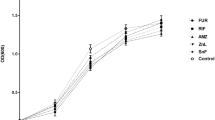Abstract
Despite the constantly increasing need for new antimicrobial agents, antibiotic drug discovery and development seem to have greatly decelerated in recent years. Presented with the significant problem of advancing antimicrobial resistance, the global scientific community has attempted to find alternative solutions; one of the most promising ones is the evaluation and use of old antibiotic compounds. A number of old antibiotic compounds, such as aminoglycosides, chloramphenicol, and tetracycline, are re-emerging as valuable alternatives for the treatment of difficult-to-treat infections. This study examined the in vitro potency for biofilm formation of five isolates (Klebsiella sp., Pseudomonas aeruginosa, Achromobacter sp., Klebsiella pneumoniae, and Bacillus pumilis) and the effects of antibiotics on these biofilms. Furthermore the quantitative analysis of planktonic, loosely attached cells, and their susceptibility to antibiotics was also determined. Twitching motility was observed to determine any effect in the biofilm forming capability of the isolates. All the isolates tested were efficient biofilm-forming strains in the polypropylene and borosilicate test tubes. Standard bacterial enumeration technique and CV staining produced equivalent results both in biofilm and planktonic assays. The biofilm formation of all the strains was affected in the presence of tetracycline or chloramphenicol. Highly significant decrease (P < 0.01) in biofilm formation was observed by treatment with chloramphenicol compared to tetracycline. In addition, the two antibiotics also affected adversely the planktonic and loosely attached cells of all isolates. Thus, testing the effects of older antibiotics on biofilms may supply useful information in addition to standard in vitro testing, particularly in diseases where biofilm formation is involved in the pathogenesis.




Similar content being viewed by others

Explore related subjects
Discover the latest articles and news from researchers in related subjects, suggested using machine learning.References
Burrows LL (2005) Weapons of mass retraction. Mol Microbiol 57:878–888
Burton E, Yakandawala N, LoVetri K et al (2007) A microplate spectrofluorometric assay for bacterial biofilms. J Ind Microbiol Biotechnol 34:1–4
Coquet L, Cosette P, Junter GA et al (2002) Adhesion of Yersinia ruckeri to fish farm materials: influence of cell and material surface properties. Colloids Surf B Biointerfaces 26:373–378
Davey ME, O’Toole GO (2000) Microbial biofilms: from ecology to molecular genetics. Microbiol Mol Biol Revs 64:847–867
Deziel E, Comeau Y, Villemur R (2001) Initiation of biofilm formation by Pseudomonas aeruginosa 57RP correlates with emergence of hyperpiliated and highly adherent phenotypic variants deficient in swimming, swarming and twitching motilities. J Bacteriol 183:1195–1204
Donlan RM, Costerton JW (2002) Biofilms: survival mechanisms of clinically relevant microorganisms. Clin Microbiol Rev 15:167–193
Falagas ME, Grammatikos AP, Michalopoulos A (2008) Potential of old-generation antibiotics to address current need for new antibiotics. Expert Rev Anti Infect Ther 6:593–600
Fonseca AP, Extremina C, Fonseca AF et al (2004) Effect of subinhibitory concentration of piperacillin/tazobactam on Pseudomonas aeruginosa. J Med Microbiol 53:903–910
Goh EB, Yim G, Tsui W et al (2002) Transcriptional modulation of bacterial gene expression by subinhibitory concentrations of antibiotics. Proc Natl Acad Sci USA 99:17025–17030
Howard J, Balbi MD (2004) Chloramphenicol (A review). Pediatr Rev 25:284–288
Langstraat J, Bohse M, Clegg S (2003) Type 3 fimbrial shaft (MrkA) of Klebsiella pneumoniae, but not the fimbrial adhesin (MrkD), facilitates biofilm formation. Infect Immun 69:5805–5812
Leid JG, Shirtliff ME, Costerton JW et al (2002) Human leukocytes adhere to, penetrate, and respond to Staphylococcus aureus biofilms. Infect Immun 70:6339–6345
Liaqat I, Sabri AN (2008) Effects of biocides on biofilm bacteria from dental unit water line biofilms. Curr Microbiol 56:619–624
Liaqat I, Sabri AN (2008) Isolation and characterization of biocides resistant bacteria from dental unit water line biofilms. J Basic Microbiol 49:1–10
Liaqat I, Bachmann RT, Sabri AN et al (2008) Investigating the effect of patulin, penicillic acid and EDTA on biofilm formation of isolates from dental unit water lines. Appl Microbiol Biotechnol 81:349–358
Linares JF, Gustafsson I, Baquero F et al (2006) Antibiotics as intermicrobial signaling agents instead of weapons. Proc Natl Acad Sci USA 103:19484–19489
Mattick JS (2002) Type IV pili and twitching motility. Annu Rev Microbiol 56:289–314
McAuliffe L, Ellis RJ, Miles K et al (2006) Biofilm formation by mycoplasma species and its role in environmental persistence and survival. Microbiology 152:913–922
Meng Y, Li Y, Galvani CD et al (2005) Upstream migration of Xylella fastidiosa via pilus-driven twitching motility. J Bacteriol 187:5560–5567
O’Toole G, Kolter R (1998) Flagellar and twitching motility are necessary for Pseudomonas aeruginosa biofilm development. Mol Microbiol 30:295–304
O’Toole G, Kaplan HB, Kolter R (2000) Biofilm formation as microbial development. Annu Rev Microbiol 54:49–79
Olofsson AC, Hermansson M, Elwing H (2003) N-acetyl-L-cysteine affects growth, extracellular polysaccharide production, and bacterial biofilm formation on solid surfaces. Appl Environ Microbiol 69:4814–4822
Passerini de Rossi B, Calenda M, Vay C, Franco M (2007) Biofilm formation by Stenotrophomonas maltophilia isolates from device-associated nosocomial infections. Rev Argent Microbiol 39:204–212
Rachid S, Ohlsen K, Witte W et al (2000) Effect of subinhibitory antibiotic concentrations on polysaccharide intercellular adhesin expression in biofilm forming Staphylococcus epidermidis. Antimicrob Agents Chemother 44:3357–3363
Shih PC, Huang CT (2002) Effects of quorum-sensing deficiency on Pseudomonas aeruginosa biofilm formation and antibiotic resistance. J Antimicrob Chemother 49:309–314
Sutherland I (2001) Biofilm EPSs: a strong and sticky framework. Microbiology 147:3–9
Van Loosdrecht MC, Lyklema J, Norde W et al (1987) The role of bacterial cell wall hydrophobicity in adhesion. Appl Environ Microbiol 53:1893–1897
Vatsos IN, Thompson KD, Adams A (2001) Adhesion of the pathogen Flavobacterium psychrophilum to unfertilized eggs of rainbow trout (Oncorhynchus mykiss) and n-hexadecane. Lett Appl Microbiol 33:178–182
Vuong C, Voyich JM, Fischer ER et al (2004) Polysaccharide intercellular adhesin (PIA) protects Staphylococcus epidermidis against major components of the human innate immune system. Cell Microbiol 6:269–275
Wirthlin MR, Marshall GW Jr, Rowland RW (2003) Formation and decontamination of biofilms in dental unit waterlines. J Periodontol 74:1595–1609
Author information
Authors and Affiliations
Corresponding author
Rights and permissions
About this article
Cite this article
Liaqat, I., Sumbal, F. & Sabri, A.N. Tetracycline and Chloramphenicol Efficiency Against Selected Biofilm Forming Bacteria. Curr Microbiol 59, 212–220 (2009). https://doi.org/10.1007/s00284-009-9424-9
Received:
Revised:
Accepted:
Published:
Issue Date:
DOI: https://doi.org/10.1007/s00284-009-9424-9
Keywords
Profiles
- Iram Liaqat View author profile



